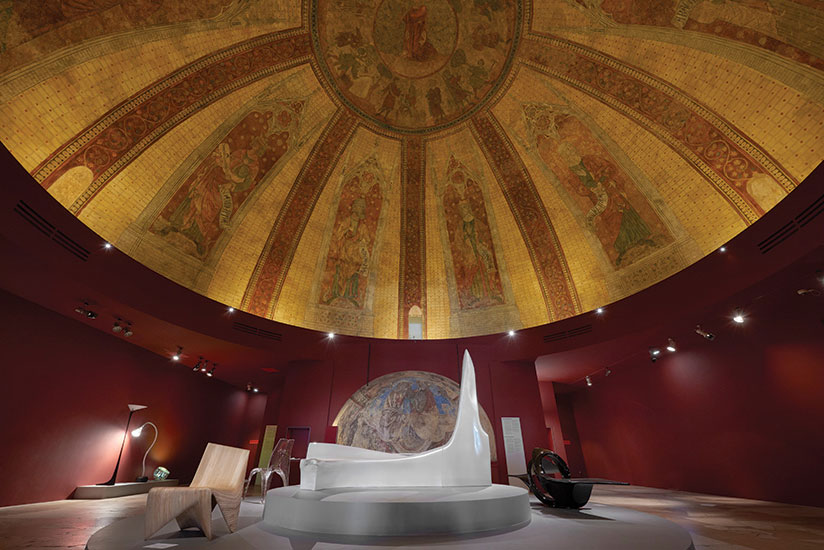If you only had one day to see France, you’d be smart to take the Metro over to the Place du Trocadéro in Paris, near the Eiffel Tower, and spend it at the Cité de l’Architecture et du Patrimoine. France’s principal architecture museum displays in the voluminous halls of the historic Palais de Chaillot a synoptic collection of monumental, full-scale Medieval and Renaissance fragments cast from the country’s most venerable buildings. With patinated surfaces that appear worn by time, the intricate casts, crowded with saints, are so convincing you have to peek around their backs to verify that the fragments are plaster and not stone. Viollet-le-Duc established the museum and its permanent collection in 1879.
If you go this month, however, you’re in for a double show. You’ll be issued a treasure map to the temporary exhibition Architects’ Furniture: 1960–2020 (open through September 30), for which the curators, headed by Lionel Blaisse in collaboration with Claire Fayolle, have sited nearly 300 often sassy, always spirited postwar pieces among the august monumental plaster fragments. The map guides you through three stories of great halls, intimate chapels, and dimly lit back passages to the modern and contemporary specimens interspersed throughout the museum.
Ron Arad’s dynamic Well Tempered Chair (1986), with pillowy sheets of stainless-steel cushions bouncing between butterfly arms, resides serenely in a dimly lit Medieval chapel with fading frescoes. An ancient dome painted with a constellation of saints hovers over Zaha Hadid’s last piece, the digitally fabricated corkscrew table called Star Wars (2016), which takes curves like the dome’s into a spiraling vortex that spins out cantilevered shelves. The stepped geometries of the freestanding pyramidal Bookcase Staircase by Claude Parent (2010), appropriately placed in the museum’s library, relates to the Eiffel Tower, seen outside through a window.
The exhibition creates a continuously fricative relationship between past and present that establishes a new paradigm for interdisciplinary shows. In the context of cathedrals, where bishops were seated on thrones, the flower power of the 1969 Bean Bag Chair by Cesare Paolini, Piero Gatti, and Franco Teodoro clearly dissents from the authority of the carved stone structures, duplicated in plaster, that establish the overall context.
You step into this unusual composite show through the plaster-cast portal of the Abbey St. Pierre in Moissac, beneath a seated God judging you on your way into a secular culture of contemporary, iconoclastic pieces. In this circuit of discovery, the unorthodox modern interlopers jolt the Romanesque, Gothic, and Neoclassical fragments to life, while the plaster fragments themselves talk back to the upstarts. Do plastic, aluminum, and recycled materials stand up to what was originally created in stone? Is design better now?
The curators start their narrative in 1960, which pointedly sets the clock after the heroic period of Modernism. Architects of the ’60s rebelled against the likes of Mies van der Rohe and Marcel Breuer and their iconic chairs (they of course had reacted against traditional furniture handcrafted in traditional materials). The 1960–2020 period represents a second generation of “modern” design as architects began to break the orthodoxy of machine-made pieces with idiosyncratic, often personal, sometimes humorous work characterized by individualism rather than a single, unifying design theory.
Here are the early Italians such as Joe Colombo, who challenged sleek Milanese design with his Tubo Chair (1969–70), a cheeky piece charged with impertinence that looks like a steamroller. Danish architect/designer Verner Panton experiments with fiberglass and plastic, creating the century’s early liquid forms.
The breakout ethos of the counterculture sent design into a deeply experimental phase, often testing materials. Gaetano Pesce tried plastics and then resins to create spongy furniture that quivers to the touch but still stands up. Ettore Sottsass and his insolent firm Memphis issued masterful declarations of design insubordination, their strident, acidic colors and argumentative parametric forms spitting in the eye of Minimalist elegance.
The curators extend the show into the digital period, to what may be the cusp of another paradigm. The show hints at a second break from Modernism but doesn’t display a critical mass of a digital era that’s doubtless in the offing, but not yet consolidated. That’s for another show in the future.
Architects’ Furniture: 1960–2020, so original in its format, offers a thorough history of a largely antihistorical period, when, with a post- Bauhaus, postindustrial mindset, designers pursued individual expression and attitude: often you sat in a concept, not in comfort. Even pieces that are decades old remain untamed and rebellious, timeless yet quirky.
Of course there were micromovements within the last half-century, and there are Postmodernist, Deconstructivist, Minimalist, and Parametric pieces, along with continuing strains of Modernism. The curators choose to represent the raucous disagreement and diversity of an era that never coalesced into one approach or look. They do not deliver a tidy, summary conclusion but correctly leave the period open-ended, as it indeed has been.
Thoroughly documented and brilliantly presented, Architects’ Furniture: 1960–2020 is an ecumenical portrait of design in a doubting, nonconformist, sometimes subversive age, and an exhibition of object lessons from the exploratory thinking that went on in that period. The show goes a long way in explaining the ideas behind the corollary phenomenon—the diverse, inventive, and liberated buildings that many of the same architects designed at the time. The show is a microcosm that suggests the macrocosm.


















